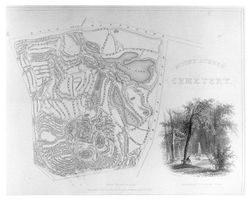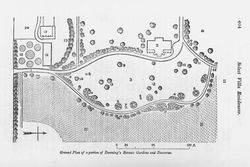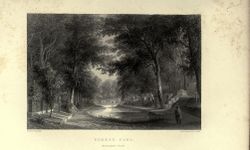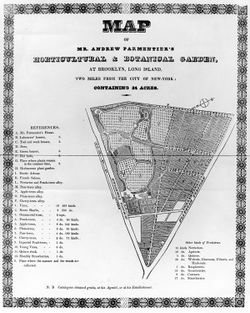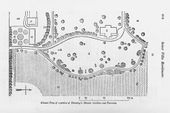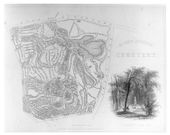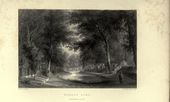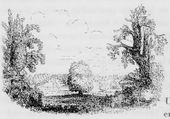Difference between revisions of "Modern style/Natural style"
| Line 24: | Line 24: | ||
| − | [[File:1063.jpg|thumb|Fig. 3, James Smillie, “Mount Auburn Cemetery,” in Cornelia W. Walter, ''Mount Auburn Illustrated'' (1850), frontispiece.]] | + | [[File:1063.jpg|thumb|Fig. 3, James Smillie, “Mount Auburn Cemetery,” in Cornelia W. Walter, ''Mount Auburn Illustrated'' (1847; repr., 1850), frontispiece.]] |
*[[H. A. S. Dearborn|Dearborn, H. A. S.]], 1832, describing [[Mount Auburn Cemetery]], Cambridge, MA (quoted in Harris 1832: 64–65)<ref>Thaddeus William Harris, ''A Discourse Delivered before the Massachusetts Horticultural Society on the Celebration of Its Fourth Anniversary, October 3, 1832'' (Cambridge, MA: E. W. Metcalf, 1832), [https://www.zotero.org/groups/54737/items/itemKey/3A3UDHF3 view on Zotero].</ref> | *[[H. A. S. Dearborn|Dearborn, H. A. S.]], 1832, describing [[Mount Auburn Cemetery]], Cambridge, MA (quoted in Harris 1832: 64–65)<ref>Thaddeus William Harris, ''A Discourse Delivered before the Massachusetts Horticultural Society on the Celebration of Its Fourth Anniversary, October 3, 1832'' (Cambridge, MA: E. W. Metcalf, 1832), [https://www.zotero.org/groups/54737/items/itemKey/3A3UDHF3 view on Zotero].</ref> | ||
:“To realize these advantages it is proposed, that a tract of land called ‘Sweet Auburn,’ situated in Cambridge, should be purchased. As a large portion of the ground is now covered with trees, [[shrub]]s, and wild flowering plants, [[avenue]]s and [[walk]]s may be made through them, in such a manner as to render the whole establishment interesting and beautiful, at a small expense, and within a few years; and ultimately offer an example of landscape or [[picturesque]] gardening, in conformity to the '''modern style''' of laying out grounds, which will be highly creditable to the Society.” [Fig. 3] | :“To realize these advantages it is proposed, that a tract of land called ‘Sweet Auburn,’ situated in Cambridge, should be purchased. As a large portion of the ground is now covered with trees, [[shrub]]s, and wild flowering plants, [[avenue]]s and [[walk]]s may be made through them, in such a manner as to render the whole establishment interesting and beautiful, at a small expense, and within a few years; and ultimately offer an example of landscape or [[picturesque]] gardening, in conformity to the '''modern style''' of laying out grounds, which will be highly creditable to the Society.” [Fig. 3] | ||
| Line 65: | Line 65: | ||
[[File:1976.jpg|thumb|Fig. 7, James Smillie (artist), John A. Rolph (etcher), “View of the Forest Pond, Mount Auburn Cemetery,” in Cornelia W. Walter, ''Mount Auburn Illustrated'' (1847; repr., 1850), opp. 94.]] | [[File:1976.jpg|thumb|Fig. 7, James Smillie (artist), John A. Rolph (etcher), “View of the Forest Pond, Mount Auburn Cemetery,” in Cornelia W. Walter, ''Mount Auburn Illustrated'' (1847; repr., 1850), opp. 94.]] | ||
| − | *Walter, Cornelia W., 1847, describing [[Mount Auburn Cemetery]], Cambridge, MA (1847 | + | *Walter, Cornelia W., 1847, describing [[Mount Auburn Cemetery]], Cambridge, MA (1847: 14)<ref>Cornelia W. Walter, ''Mount Auburn Illustrated'' (New York: Martin and Johnson, 1847), [https://www.zotero.org/groups/54737/items/itemKey/CN79BMN8 view on Zotero].</ref> |
:“The [[avenue]]s are winding in their course and exceedingly beautiful in their gentle circuits, adapted picturesquely to the inequalities of the surface of the ground, and producing charming landscape effects from this '''natural''' arrangement, such as could never be had from straightness or regularity.” [Fig. 7] | :“The [[avenue]]s are winding in their course and exceedingly beautiful in their gentle circuits, adapted picturesquely to the inequalities of the surface of the ground, and producing charming landscape effects from this '''natural''' arrangement, such as could never be had from straightness or regularity.” [Fig. 7] | ||
Revision as of 19:56, May 30, 2018
History

Treatises usually defined the modern style in contrast to the ancient style. The opening vignette from A. J. Downing’s A Treatise on the Theory and Practice of Landscape Gardening (1849) clearly makes this point in its pairing of two contrasting views of garden design [Fig. 1]. On the left, the ancient style is represented by a bilaterally asymmetrical layout with a straight avenue bordered by rows of trees; whereas on the right, clusters of trees are irregularly arranged in the landscape, in harmony with natural surroundings. J. C. Loudon (1826) defined the modern style simply as a collection of irregular groups and masses placed around the house to unite it with the open lawn. This duality, which has continued since the 17th century, was known as the battle of the ancients and the moderns: an intellectual quarrel over the commitment to ancient authors and culture versus the interest in new science, inspired by the teachings of Francis Bacon. The reconciliation of the achievements in ancient rhetoric, oratory, poetry, and history with the new natural philosophy liberated from ancient authority marked aesthetic argument well into the 19th century.[1]
In 1806 Bernard M’Mahon stated that the modern style of gardening had overtaken the ancient, which then was almost abolished. Thus he provided both a chronological reference, as well as a formal comparison of the two styles. M’Mahon wrote that in contrast to the ancient mode, the modern form offered rural open spaces of varied forms, winding walks, and a variety of rural ground “in imitation of a natural assemblage.” Although this synonymous use of “modern” and natural style was consistent throughout the period, he emphasized that the modern style was more than an imitation of nature as an art resulting from the combination of art and nature. For him, variety, diversity in parts and shapes, views and boundaries were key elements in designing a garden in the modern taste.

Very often the term “natural style” was used as an alternative to “modern style” in landscape gardening. Downing, for example, claimed that in Europe the natural style was a term synonymous with not just the modern but also the English style. This style was characterized by its harmony with natural surroundings and thus was set in opposition to the artificial style [Fig. 2]. The duality of the terms “natural” and “artificial” seemed to be less frequently used than that of “modern” and “ancient,” or “natural” and “geometric.” Edgar Allan Poe was a prominent exception; in his short story, “The Landscape Garden” (1832), he used the terms “natural” and “artificial” exclusively to describe the two branches of landscape gardening.
Downing wrote that the modern style was carried to its greatest perfection in England. Although he referred to several English gardens in his Treatise, he did not mention any continental ones because the geometric style still prevailed there.[2] Downing recommended Horace Walpole’s “On Modern Gardening” (1780) because it was “devoted to the improvement of landscape Gardening in the modern or natural style.”[3]
Although he clearly preferred the modern style, Downing (1836) explained that in America, “where nature still riots unsubdued,” landed proprietors had to exercise a discriminating taste by taking advantage of the location and producing the style that would afford the greatest pleasure, whether modern or ancient. It is this openness to a myriad of garden styles that characterized the eclecticism of the early 19th century in American garden history.
In its usage, the modern style was presented either as a branch of landscape gardening or as synonymous with landscape gardening. It was also frequently used synonymously with natural or English styles. One of the qualities most admired in the modern style was variety, which André Parmentier in his 1828 article about picturesque gardening claimed “presents to you a constant change in scene.” His botanical gardens and nurseries were described several times as a premier example of “the most modern style.”
—Therese O’Malley
Texts
Usage
- Viator [pseud.], August 15, 1828, “Nurseries and Gardens on Long Island,” describing André Parmentier’s horticultural and botanical garden, Brooklyn, NY (New England Farmer 7: 25)[4]
- “This garden, so far as completed, has been laid out by the very intelligent proprietor in the most modern style and with great taste; for in the branch of ornamental and picturesque gardening, Mr. Parmentier, it is believed, greatly excels.”
- Dearborn, H. A. S., 1832, describing Mount Auburn Cemetery, Cambridge, MA (quoted in Harris 1832: 64–65)[5]
- “To realize these advantages it is proposed, that a tract of land called ‘Sweet Auburn,’ situated in Cambridge, should be purchased. As a large portion of the ground is now covered with trees, shrubs, and wild flowering plants, avenues and walks may be made through them, in such a manner as to render the whole establishment interesting and beautiful, at a small expense, and within a few years; and ultimately offer an example of landscape or picturesque gardening, in conformity to the modern style of laying out grounds, which will be highly creditable to the Society.” [Fig. 3]
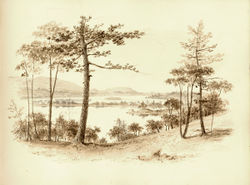
- Downing, A. J., January 1837, “Notices on the State and Progress of Horticulture in the United States” (Magazine of Horticulture 3: 8)[6]
- “The finest single example of landscape gardening, in the modern style, is at Dr. Hosack’s seat, Hyde Park, and the best specimens of the ancient or geometric style may probably be met with in the neighborhood of Philadelphia.” [Fig. 4]
- Hovey, C. M., November 1839, “Notices of Gardens and Horticulture, in Salem, Mass.,” describing Elfin Glen, residence of P. Dodge, Salem, MA (Magazine of Horticulture 5: 404)[7]
- “The cottage stands near the road, and is entered from the west front; on the south end is a piazza; the drawing-room opens into this, and thence into the garden to an open space, answering somewhat the purpose of a terrace, neatly gravelled; a walk from thence conducts directly, in a straight line, nearly to the edge of the river, where it terminates in a rustic arch and vase on the lawn; on each side of the walk there is turf, with circles of flowers at the distance of ten or twelve feet; these are each backed by a line of buckthorn hedges, with a view to screen both the fruit garden on the east, and the vegetable garden on the west, from sight. As much as we dislike criticism in such a case as this, we must admit that this has too set an appearance for a garden in the modern style; our ideas, in regard to picturesque gardening, or, rather, what may be called the gardenesque style, are, perhaps, somewhat known, and some of our readers might think it singular for us not at once to disapprove of such taste. We have suggested to Mr. Dodge what we consider a great improvement, and have advised the removal of at least one of the hedges, and other alterations, which we think would add greatly to the beauty of the grounds.”
- Hovey, C. M., September 1840, “Notes on Gardens and Gardening, in New Bedford, Mass.,” describing the estate of James Arnold, New Bedford, MA (Magazine of Horticulture 6: 362–63)[8]
- “Mr. Arnold’s grounds are decidedly the most ornamental that we have ever seen, and convey to those who have not a good conception of the modern or English style of gardening, a better idea of what this style consists in, than they could learn by reading a hundred descriptions of the same. . . .
- “The house stands about one hundred and fifty feet from the street; a broad carriage-way enters on one side, and, sweeping by the entrance to the house, in a semicircular form, opens to the street on the opposite side. Between this carriage-way and street there is a fine lawn; this is varied by two or three elegant groups of trees, which break the view of the house from the street, and likewise convey an idea of greater extent, by partly preventing those who are entering upon the approach from seeing those who are departing from the house.”
- Hovey, C. M., November 1841, “Select Villa Residences,” describing Highland Place, estate of A. J. Downing, Newburgh, NY (Magazine of Horticulture 7: 402)[9]
- “Mr. Downing’s house is situated on the upper piece, or that farthest from the river, and the annexed ground plan represents a portion of this lot, laid out in the modern or English style.” [Fig. 5]
- W., February 1842, describing Lowell Cemetery, Lowell, MA (Magazine of Horticulture 8: 50)[10]
- “In laying out these grounds, the skill of the designer has been displayed, in combining somewhat the ‘ancient or geometric style’ with the natural or irregular. In some parts, the regular forms and right lines are well adapted to the location of the ground, while in others, the varied and gradually curving forms give an air of grandeur and boldness, and in combining these with the natural scenery, cannot fail to call forth, in the minds of visitors, impressions of love and veneration.”
- Downing, A. J., 1851, describing plans for improving the public grounds of Washington, DC (quoted in Washburn 1967: 54–55)[11]
- “My object in this Plan has been three-fold:
- “1st: To form a national Park, which should be an ornament to the Capital of the United States; 2nd: To give an example of the natural style of Landscape Gardening which may have an influence on the general taste of the Country. . . .
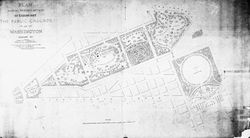
- “4th: Smithsonian Park or Pleasure Grounds.
- “An arrangement of choice trees in the natural style, the plots near the Institution would be thickly planted with the rarest trees and shrubs, to give greater seclusion and beauty to its immediate precincts.” [Fig. 6]
- Horticola [pseud.], March 1852, “Notes on Gardens and Country Seats Near Boston,” describing Oakley Place, seat of William Pratt, Boston, MA (Horticulturist 7: 127)[12]
- “OAKLEY PLACE, the residence of Mrs. PRATT, is near Mr. CUSHING’S, and presents a fine specimen of a small country place, combining the picturesque and the natural—the gardenesque and the wild, in beautiful harmony together.”
- Walter, Cornelia W., 1847, describing Mount Auburn Cemetery, Cambridge, MA (1847: 14)[13]
- “The avenues are winding in their course and exceedingly beautiful in their gentle circuits, adapted picturesquely to the inequalities of the surface of the ground, and producing charming landscape effects from this natural arrangement, such as could never be had from straightness or regularity.” [Fig. 7]
Citations
- Heely, Joseph, 1777, Letters on the Beauties of Hagley, Envil, and the Leasowes (1777; repr., 1982: 1:55–58; also quoted in O’Neal 1976: 150)[14]
- “Beauty in gardening, as I observed before, does not consist in perfect symmetry, as in architecture; it is composed, and ever delights, in a sympathizing irregularity. . . .
- “This is the grand chain on which the principles of modern gardening depend; and what should never be out of the eye of the designer: if one link be broken in the most insignificant object, it is of such consequence, that the whole may fall into censure, and other parts be sullied by its deformity.
- “You will conclude that great expences must consequently attend the performance of a gay, modern design. . . .
- “Since gardening has emerged from its former vicious, and puerile state, the delightful scenery that has sprung from the pure principles of the modern practice, is really admirable. The science has been brought into such perfection, that in many places, the greatest difficulty is to discover where art has been busy to arrive at it; so simple, yet so elegant; every scene so beautifully characterised; so different, yet so configurative!”
- Walpole, Horace, 1784 [or 1780?], “On Modern Gardening” (repr., 1876: 74, 88–89)[15]
- “It is necessary that the concurrent testimony of the age should swear to posterity that the description above-quoted was written above [sic] half a century before the introduction of modern gardening, or our incredulous descendants will defraud the poet of half his glory, by being persuaded that he copied some garden or gardens he had seen—so minutely do his ideas correspond with the present standard. But what shall we say for that intervening half century which could read that plan and never attempt to put it in execution? . . .
- “Sir Henry Englefield was one of the first improvers on the new style, and selected with singular taste that chief beauty of all gardens, prospect, and fortunate points of view. We tire of all the painter’s art when it wants these finishing touches. The fairest scenes, that depend on themselves alone, weary when often seen. The Doric portico, the Palladian bridge, the Gothic ruin, the Chinese pagoda, that surprise the stranger, soon lose their charms to their surfeited master. The lake that floats the valley is still more lifeless, and its lord seldom enjoys his expense but when he shows it to a visitor. But the ornament whose merit soonest fades is the hermitage, or scene adapted to contemplation. . . . The method of living is now totally changed, and yet the same superb palaces are still created, becoming a pompous solitude to the owner, and a transient entertainment to a few travellers. If any incident abolishes or restrains the modern style of gardening, it will be this circumstance of solitariness. The greater the scene, the more distant it is probably from the capitol; in the neighbourhood of which land is too dear to admit considerable extent of property. Men tire of expense that is obvious to few spectators. Still, there is a more imminent danger that threatens the present, as it has ever done all taste—I mean the pursuit of variety.”
- M’Mahon, Bernard, 1806, The American Gardener’s Calendar (1806: 55–56)[16]
- “In designs for a Pleasure-ground, according to modern gardening; consulting rural disposition, in imitation of nature; all too formal works being almost abolished, such as long straight walks, regular intersections, square grass-plats, corresponding parterres, quadrangular and angular spaces, and other uniformities, as in ancient designs; instead of which, are now adopted, rural open spaces of grass-ground, of varied forms and dimensions, and winding walks, all bounded with plantations of trees, shrubs, and flowers, in various clumps; other compartments are exhibited in a variety of imitative rural forms; such as curves, projections, openings, and closings, in imitation of a natural assemblage; having all the various plantations and borders, open to the walks and lawns.
- “In designs for a Pleasure-ground, according to modern taste, a tract of ground of any considerable extent, may have the prospect varied and diversified exceedingly, in a beautiful representation of art and nature, as that in passing from one compartment to another, still new varieties present themselves, in the most agreeable manner; and even if the figure of the ground is irregular, and the surface has many inequalities, the whole may be improved without any great trouble of squaring or levelling; for by humouring the natural form, you may cause even the very irregularities and natural deformities, to carry along with them an air of diversity and novelty, which fail not to please and entertain most observers.”
- Loudon, J. C., 1826, An Encyclopaedia of Gardening (1826: 792–93, 996, 1021)[17]
- “6093. . . . The modern style is a collection of irregular groups and masses, placed about the house as a medium, uniting it with the open lawn. . . .
- “7161. With respect to the modern style, considered as including what belongs to the conveniences of a country-residence, as well as the art of creating landscapes, Pope has included the principles under, 1st, The study and display of natural beauties; 2d, The concealment of defects; and 3d, Never to lose sight of common sense. Wheatley concurs in these principles, stating the business of a gardener to be ‘to select and to apply whatever is great, elegant, or characteristic’ in the scenery of nature or art; ‘to discover and to show all the advantages of the place upon which he is employed; to supply its defects, to correct its faults, and to improve its beauties.’ Repton, whose observations on landscape-gardening bear on the title-page, to be ‘written with a view to establish fixed principles in these arts,’ enumerates congruity, utility, order, symmetry, scale, proportion, and appropriation, as principles, ‘if,’ as he observes, in one place, ‘there are any principles.’ Mason places the secret of the art in the ‘nice distinction between contrast and incongruity;’ Mason, the poet, invokes ‘simplicity,’ probably intending that this beauty should distinguish the English from the Chinese style: simplicity is also the ruling principle of Lord Kames; Girardin includes every beauty under ‘truth and nature,’ and every rule ‘under the unity of the whole, and the connection of the parts;’ and Shenstone states, ‘landscape or picturesque gardening’ to ‘consist in pleasing the imagination,’ by scenes of grandeur, beauty, and variety. Convenience merely has no share there, any farther than as it pleases the imagination. Congruity and the principles of painting are those of Price and Knight; and nature, utility, and taste, those of Marshall. From these different theories, as well as from the general objects or end of gardening, there appear to be two principles which enter into its composition; those which regard it as a mixed art, or an art of design, and which are called the principles of relative beauty; and those which regard it as an imitative art, and are called the principles of natural or universal beauty. The ancient or geometric gardening is guided wholly by the former principles; landscape-gardening, as an imitative art, wholly by the latter; but as the art of forming a country-residence, its arrangements are influenced by both principles. In conformity with these ideas, and with our plan of treating both styles, we shall first consider its principles as an inventive or mixed, and secondly as an imitative art. . . .
- “7265. The park. . . . In the modern style, the scenery of a park is intended to resemble that of a scattered forest, the more polished glades and regular shapes of lawn being near the house, and the rougher parts towards the extremities.”
- Parmentier, André, 1828, The New American Gardener (quoted in Fessenden 1828: 185)[18]
- “Where is the person, gifted with any taste, who would not choose those alleys that wind without constraint, in preference to those dull straight lines which can be measured by one glance of the eye, and the monotony of which is unvaried? Instead of this, the modern style presents to you a constant change of scene, perfectly in accordance with the desires of a man who loves, as he continues his walk, to have new objects laid open to his view.” [Fig. 8]
- Loudon, J. C., 1834, An Encyclopaedia of Gardening (1834: 1170)[19]
- “6728. A very common error, since the introduction of the modern style, has been to suppose that picturesque beauty is the only beauty to be aimed at in laying out grounds: but, so far from this being the case, it will often happen that the alterations required for the purposes of convenience and character, will lessen that beauty, while it increases that of dignity, refinement, and appropriation to man.”
- Downing, A. J., August 1836, “Remarks on the Fitness of the different Styles of Architecture for the Construction of Country Residences, and on the Employment of Vases in Garden Scenery” (American Gardeners’ Magazine 2: 284–85)[20]
- “It is needless to lay down any rules for the formation of this approach-road, as, in all cases, it will depend so much upon the situation. We would rather rely upon a general unity of expression, than upon any fixed rules. Neither do we conceive that, in this country, we are by any means bound to follow undeviatingly the European modern style of laying out the grounds. In a highly cultivated country like England, where the most striking features of nature are in a great measure effaced by art, a pleasure-ground, formed in the natural style, is capable, by contrast, of affording the greatest pleasure. For the same reason, here, where nature still riots unsubdued in all her magnificence and grandeur, it would, in many cases, be idle and absurd to attempt to imitate her. An artificial cascade, or the water-works of Versailles, would be but paltry affairs, if placed by the side of Niagara. There is, however, room for the display of various styles, as well in laying out ground as in building, and, in the neighborhood of the old Atlantic cities, well kept grounds, in the modern style, would be at once appropriate and delightful. So also in those wilder situations in the country, where nature exists in her pristine loveliness, the eye is occasionally delighted to witness the work of art—a fine building and a stately avenue. In short, the ultimatum of our wishes is, to see our numerous and intelligent landed proprietors exercising a well cultivated and nicely discriminating taste, with which, taking advantage of the location, they would produce, in their buildings and grounds, the greatest beauty and enjoyment, combined with a perfect harmony of expression, in the whole scene.”
- Anonymous, April 1, 1837, “Landscape Gardening” (Horticultural Register 3: 123–24)[21]
- “Formerly it was the universal practice to dispose all the parts of ornamental grounds generally, in squares, right lines, circles and other mathematical figures; and a regularity of arrangement was observed amounting sometimes to the utmost stiffness. This has, and more especially as it relates to shrubbery and trees, given way to the modern and more improved style; to freer and more varied forms; to a plan of embellished nature, imitative of the scenery of a real landscape. The old style addressed itself more to a love of novelty than to the taste; hence grotesque and imitative forms were largely introduced; trees were shorn into the form of pyramids and statues, hedges were made to resemble smooth walls, and every effort was made
- To form with verdure what the builder formed
- With stone. From the novelty of such objects, many, even at
- the present time, prefer the old style, but the pleasure arising from this love of novelty is soon exhausted. But the almost endless diversity of the natural landscape presents an inexhaustible store of new forms. . . .
- “Confining ourselves to the modern or natural style, we shall proceed to offer some remarks on its characteristics. Landscape gardens in this style generally present either picturesque, or what is termed gardenesque scenery.”
- Poe, Edgar Allan, October 1842, “The Landscape-Garden” (1842: 326)[22]
- “‘There are, properly,’ he writes, ‘but two styles of landscape-gardening, the natural and the artificial. One seeks to recall the original beauty of the country, by adapting its means to the surrounding scenery; cultivating trees in harmony with the hills or plain of the neighboring land; detecting and bringing into practice those nice relations of size, proportion, and color which, hid from the common observer, are revealed every where to the experienced student of nature. The result of the natural style of gardening, is seen rather in the absence of all defects and incongruities—in the prevalence of a beautiful harmony and order, than in the creation of any special wonders or miracles. The artificial style has as many varieties as there are different tastes to gratify. It has a certain general relation to the various styles of building. There are the stately avenues and retirements of Versailles; Italian terraces; and a various mixed old English style, which bears some relation to the domestic Gothic or English Elizabethan architecture. Whatever may be said against the abuses of the artificial landscape-gardening, a mixture of pure art in a garden scene, adds to it a great beauty. This is partly pleasing to the eye, by the show of order and design, and partly moral. A terrace, with an old moss-covered balustrade, calls up at once to the eye, the fair forms that have passed there in other days. The slightest exhibition of art is an evidence of care and human interest.’”
- Watterston, George, May 1844, “Landscape Gardening” (1844: 310–11)[23]
- “In passing from the ancient, or geometric style, to the modern, or natural, the first improvers fell, perhaps, into an opposite extreme. This is the danger in all sudden transitions. They seemed to conceive that crooked lines, serpentine windings and carelessness were true objects of beauty, and declared that nature abhorred a straight line; and thus fatigued the eye by incessant curves. They did not seem to be aware, that in her sublimest works nature prefers the straight line, as is shown in the apparent horizon of the ocean and the rays of the sun.”
- Downing, A. J., 1849, A Treatise on the Theory and Practice of Landscape Gardening (1849; repr., 1991: 38–39)[24]
- “On the continent of Europe, thought there are a multitude of examples of the modern style of landscape gardening, which is there called the English or natural style, yet in the neighborhood of many of the capitals, especially those of the south of Europe, the taste for the geometric or ancient style of gardening still prevails to a considerable extent; partially, not doubt, because that style admits, with more facility, of those classical and architectural accompaniments of vases, statues, busts, etc., the passion for which pervades a people rich in ancient and modern sculptural works of art.”

- Ranlett, William H., 1849, The Architect (1849; repr., 1976: 1:4, 33)[25]
- “In late improvements, it [[[landscape gardening]]] consists in the imitation of nature, in curved walks and winding waters, and trees and clumps of natural shape: hence the present mode is called the natural style. . . .
- “[Design V.] PLATE 23.—Ground plot, showing the location of the house, walks, roads, &c. in the natural style, with hedge and shrub borders.” [Fig. 9]
- Meehan, Thomas, February 1852, “Notes on Landscape Gardening” (Horticulturist 7: 92)[26]
- “Landscape gardening, to be pleasing, must be accommodating. Nature herself, is so. In the plains she will give the Oak, the Beech, the Birch, a giant height and strength; on the hill sides and elevations she checks their luxuriance—while on the mountain summits she reduces them to the rank of mere bushes. They, therefore, who follow the ‘natural style,’ may learn from this, that its results depend on their application of natural laws, rather than on any abstract formulas of lines or circles. Mankind generally run into extremes. Landscape gardening confirms this truth. The old system of squaring all walks, carrying them at right lines and angles, shearing and clipping every tree, and making everything so exactly correspondent, was so very absurd.”
Images
Inscribed
Anonymous, “Plan of a Mansion Residence, laid out in the natural style,” in A. J. Downing, A Treatise on the Theory and Practice of Landscape Gardening, 4th ed. (1849), 115, fig. 25.
Associated
Frances Palmer, “Ground Plot of Brier Cottage,” in William H. Ranlett, The Architect (1849), vol. 1, pl. 2.
Frances Palmer, Ground plot of a cottage, in William H. Ranlett, The Architect (1849), vol 1, pl. 23.
Anonymous, Vignette of contrasting garden styles, in A. J. Downing, A Treatise on the Theory and Practice of Landscape Gardening, 4th ed. (1849), 17. The “modern style,” depicted on the right, is contrasted with the more regular, symmetrical “ancient style” on the left.
A. J. Downing, Plan Showing Proposed Method of Laying Out the Public Grounds at Washington, 1851. Manuscript copy by Nathaniel Michler, 1867.
A. J. Downing, Plan showing proposed method of laying out the public grounds at Washington, 1851.
Alexander Jackson Davis, View of water with islands (Hyde Park), n.d.
Attributed
Notes
- ↑ Joseph M. Levine, “John Evelyn: Between the Ancients and the Moderns,” in John Evelyn’s Elysium Britannicum and European Gardening, ed. Therese O’Malley and Joachim Wolschke-Bulmahn (Washington, DC: Dumbarton Oaks Research Library and Collection, 1998), 57–78,view on Zotero.
- ↑ Judith Major, To Live in the New World: A. J. Downing and American Landscape Gardening (Cambridge, MA: MIT Press, 1997), 42–43, view on Zotero.
- ↑ A. J. Downing, A Treatise on the Theory and Practice of Landscape Gardening (New York and London: Wiley and Putnam; Boston: C. C. Little, 1841), 17, view on Zotero.
- ↑ Viator, “Nurseries and Gardens on Long Island,” The New England Farmer, and Horticultural Journal 7, no. 4 (August 15, 1828): 25, view on Zotero.
- ↑ Thaddeus William Harris, A Discourse Delivered before the Massachusetts Horticultural Society on the Celebration of Its Fourth Anniversary, October 3, 1832 (Cambridge, MA: E. W. Metcalf, 1832), view on Zotero.
- ↑ Andrew Jackson Downing, “Notices on the State and Progress of Horticulture in the United States,” The Magazine of Horticulture, Botany, and All Useful Discoveries and Improvements in Rural Affairs 3, no. 1 (January 1837): 1–10, view on Zotero.
- ↑ Charles Mason Hovey, “Notices of Gardens and Horticulture, in Salem, Mass.,” The Magazine of Horticulture, Botany, and All Useful Discoveries and Improvements in Rural Affairs 5, no. 11 (November 1839): 401–16, view on Zotero.
- ↑ Charles Mason Hovey, “Notes on Gardens and Gardening, in New Bedford, Mass.”, The Magazine of Horticulture, Botany, and All Useful Discoveries and Improvements in Rural Affairs 6, no. 9 (September 1840): 361–66, view on Zotero.
- ↑ Charles Mason Hovey, “Select Villa Residences, with Descriptive Notices of Each; Accompanied with Remarks and Observations on the Principles and Practice of Landscape Gardening: Intended with a View to Illustrate the Art of Laying Out, Arranging, and Forming Gardens and Ornamental Grounds,” The Magazine of Horticulture, Botany, and All Useful Discoveries and Improvements in Rural Affairs 7, no. 11 (November 1841): 401–11, view on Zotero.
- ↑ W., “An Account of the Lowell Cemetery, Its Situation, Historical Associations, and Particular Description,” The Magazine of Horticulture, Botany, and All Useful Discoveries and Improvements in Rural Affairs 8, no. 2 (February 1842): 47–50, view on Zotero.
- ↑ Wilcomb E. Washburn, “Vision of Life for the Mall,” AIA Journal 47 (1967): 52–59, view on Zotero.
- ↑ Horticola [pseud.], “Notes on Gardens and Country Seats near Boston,” The Horticulturist and Journal of Rural Art and Rural Taste 7, no. 3 (March 1852): 126–28, view on Zotero.
- ↑ Cornelia W. Walter, Mount Auburn Illustrated (New York: Martin and Johnson, 1847), view on Zotero.
- ↑ Joseph Heely, Letters on the Beauties of Hagley, Envil, and the Leasowes, 2 vols.(1777; repr., New York: Garland, 1982), view on Zotero.
- ↑ Horace Walpole, “On Modern Gardening,” in Anecdotes of Painting in England; with Some Account of the Principal Artists, ed. Ralph N. Wornum (London: Chatto and Windus, 1876), iii, 63–93, view on Zotero.
- ↑ Bernard M’Mahon, The American Gardener’s Calendar: Adapted to the Climates and Seasons of the United States. Containing a Complete Account of All the Work Necessary to Be Done . . . for Every Month of the Year . . . (Philadelphia: Printed by B. Graves for the author, 1806), view on Zotero.
- ↑ J. C. (John Claudius) Loudon, An Encyclopaedia of Gardening; Comprising the Theory and Practice of Horticulture, Floriculture, Arboriculture, and Landscape-Gardening, 4th ed. (London: Longman et al., 1826), view on Zotero.
- ↑ Thomas Fessenden, The New American Gardener (Boston: J. B. Russell, 1828), view on Zotero.
- ↑ J. C. (John Claudius) Loudon, An Encyclopaedia of Gardening; Comprising the Theory and Practice of Horticulture, Floriculture, Arboriculture, and Landscape-Gardening, new ed. (London: Longman et al., 1834), view on Zotero.
- ↑ A. J. Downing, “Remarks on the Fitness of the different Styles of Architecture for the Construction of Country Residences, and on the Employment of Vases in Garden Scenery,” The American Gardeners’ Magazine, and Register of Useful Discoveries and Improvements in Horticulture and Rural Affairs 2, no. 8 (August 1836): 281–86, view on Zotero.
- ↑ Anonymous, “Landscape Gardening,” Horticultural Register, and Gardener’s Magazine 3 (April 1, 1837): 121–31, view on Zotero.
- ↑ Edgar Allan Poe, “The Landscape-Garden,” Ladies’ Companion 17 (October 1842): 324–27, view on Zotero.
- ↑ George Watterston, “Landscape Gardening,” Southern Literary Messenger 10 (May 1844): 306–15, view on Zotero.
- ↑ A. J. [Andrew Jackson] Downing, A Treatise on the Theory and Practice of Landscape Gardening, Adapted to North America, 4th ed. (1849; repr., Washington, DC: Dumbarton Oaks Research Library and Collection, 1991), view on Zotero.
- ↑ William H. Ranlett, The Architect, 2 vols. (1849–51; repr., New York: Da Capo, 1976), view on Zotero.
- ↑ Thomas Meehan, “Notes on Landscape Gardening,” The Horticulturist and Journal of Rural Art and Rural Taste 7, no. 2 (February 1852): 92–94, view on Zotero.
